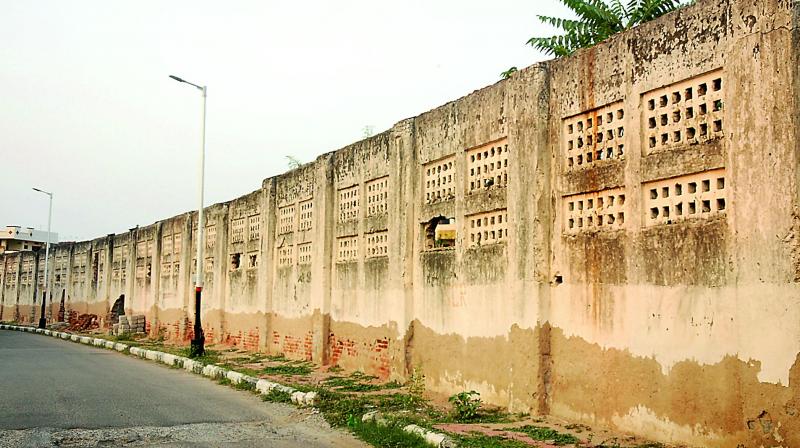Hyderabad: Wall near Kacheguda is testimony of a bygone era

Hyderabad: The wall is lonesome, curving along the road with empty windows and gaping holes within. Till someone tells you that this was built with a purpose and not just by some eccentric mason, no passerby will know that this was the purdah wall specially built for women passengers to embark and disembark coaches which would then be joined to the main train at the Kacheguda railway station.
The ladies coach would be brought on a separate line and parked behind the wall for the ladies to board. There was also a waiting room, so the women could board the train in privacy. While the wall is still in place, there is no sign of the waiting room.
Unless the wall gets some historic significance, it will soon be destroyed and this small, indulgent gesture for womenfolk will be forgotten. The wall is almost a couple of furlongs away from the main station. The earlier ‘zanana siding’ has become an engine siding nowadays, and four to five locomotives are parked there.
The Kacheguda station was the real Hyderabad station. The Secunderabad station was more of a colonial structure built for British soldiers. Today’s Hyderabad station, at Nampally, though built in 1907 by Mir Osman Ali Khan, the VII Nizam, was used as a goods siding. The first passenger train came only in 1921.
The Kacheguda station was built 102 years ago, in 1916, by the Nizam. There is a legend which states that the name Kacheguda came by because of the presence of the Kachi community, apparently an agricultural community from North India. They came here as infantry and cavalry soldiers.
Kacheguda might be the most beautiful station in South Central Railway, the facade has been maintained. The main building speaks of a new architecture, called the Osmanian style, which is a mixture of the prevailing architectural styles then, including Islamic,Rajasthani, Hindu, Buddhist, etc.
The first representation of this kind of mixed architectural style can be seen atwhat is now recognised as the Assembly, but what was earlier the Town Hall, Osmania Hospital, the High Court building. A lot of thought had gone into building this station, including ventilation and light, with jalis right in the front and maintained through the entrance. Since this station was meant for metre gauge trains, the station was at a lower level.
The exterior looks more like a palace, with a central dome, two side domes and many minarets. The station has been extended and efforts have been made to copy the architecture style. The old time charm is somehow still maintained and Intach in its appreciation of this awarded the station in 2004. While the station was architecturally different, it also goes to show that the Nizam took great interest and pride in this station.
Kacheguda was also the headquarters of the then Nizam Guaranteed State Railway. This was a public limited company based out of London in which the Nizam had shares. It was also supported by the Samasthanams and other Hyderabadis. The Nizam bought all the shares in 1930 and this was recognised as the Nizam State Railways. Along with the railways, the Nizam saw to it that Hyderabad was well connected by buses and flights too.
There was also the Godavari Valley Light Railway which was commenced in 1900 and gained popularity because of its train connection to Manmad. There were several other routes, but this was the most popular, because it later connected to the Great Indian Peninsula Railway which in turn connected to Bombay. The Dronachalam connection came in 1929 which further connected Hyderabad deeper south including Madras through the Southern Mahratta Railway. Kacheguda became an important junction and all these connections boosted trade in textiles, oil and other stuff.
The Kacheguda station also has a museum, which is kept closed on Sundays and where nothing of the old memories is kept. A John Wallace fire engine and a railway coach which the Nizam used are kept in the Delhi museum. There is no single locomotive engine kept at this beautiful station, even as a memory.
Luckily a wooden staircase still exists, leading to the first floor of the building. Under the main dome is a beautiful room which was for the station master. Now the rooms, which were well appointed and also had a VIP room, are used to store things.
The Nizam wanted Hyderabad to be part of the trade route with connections to larger cities like Bombay and Madras. To improve tourism, there was a special train to the famous heritage caves of Ajanta and Ellora.
A train called the Ajanta Express would leave Kacheguda and go via Nizamabad, Nanded and Aurangabad. This was the last point of the Nizam’s territory and of the Hyderabad state. For the comfort of the passengers the railways built a beautiful hotel called the Ajanta Hotel at Aurangabad. This was later handed over to a commercial hotel and they promptly demolished the old building.
The Ajanta Express for later called the Kacheguda Express and then discontinued for some time. It was restarted from Secunderabad.
According to railway history, the train was introduced on April 1, 1867, as a metre gauge train between Kacheguda railway station and Manmad, via Nizamabad, Nanded and Aurangabad. The train became popular in a short time as Manmad Junction was converted to broad gauge which would connect Hyderabad to other destinations.

